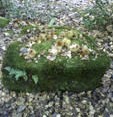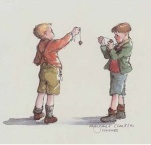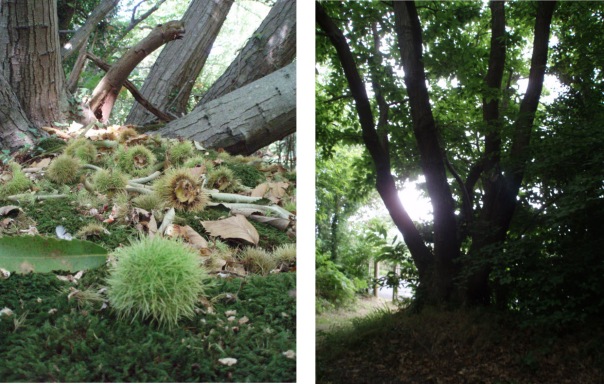Originally published November 2009
 Hello everyone! The Pythonesque amongst you should be able to provide an extensive list in response to this month’s title; the aqueduct, sanitation, roads etc. However you may not be aware that they also provided the first line to Mel Tormé’s Christmas Song, the subject for at least one Turner painting, a staple ingredient for every celebrity chef to drool over in the festive season and of course a deciduous favourite of our British woodlands. The common link… chestnuts!
Hello everyone! The Pythonesque amongst you should be able to provide an extensive list in response to this month’s title; the aqueduct, sanitation, roads etc. However you may not be aware that they also provided the first line to Mel Tormé’s Christmas Song, the subject for at least one Turner painting, a staple ingredient for every celebrity chef to drool over in the festive season and of course a deciduous favourite of our British woodlands. The common link… chestnuts!
 The Sweet Chestnut (Castanea sativa) has been cultivated in the Mediterranean region for at least 3000 years, and was brought to our shores by the Great Sandal’d and Toga’d Ones who ground the seeds to make flour. This time last year I referred very briefly to chestnuts as part of our natural harvest and the the race to gather them before the squirrels feast. Their ‘dining table’ can be seen down by the pond complete with evidence of their last meal.
The Sweet Chestnut (Castanea sativa) has been cultivated in the Mediterranean region for at least 3000 years, and was brought to our shores by the Great Sandal’d and Toga’d Ones who ground the seeds to make flour. This time last year I referred very briefly to chestnuts as part of our natural harvest and the the race to gather them before the squirrels feast. Their ‘dining table’ can be seen down by the pond complete with evidence of their last meal.
Do not commit the botanically heinous crime of associating the Sweet Chestnut with the Horse Chestnut (Aesculus Hippocastanum), a relative newcomer, having been introduced to Britain in the 1600s as an ornamental tree for parks and gardens. Those of us raised in less politically correct times will remember playing conkers (or conquerors as it was originally called!) in the school playground.  This involved trying a whole raft of ingenious methods to get your conker hard enough to smash Smith of the Lower Third’s dubious eighty-seven-er to pulp. I favoured soaking mine in vinegar and placing them up the chimney to bake, with reasonable success!
This involved trying a whole raft of ingenious methods to get your conker hard enough to smash Smith of the Lower Third’s dubious eighty-seven-er to pulp. I favoured soaking mine in vinegar and placing them up the chimney to bake, with reasonable success!
I could write a series of articles on A Hippocastanum, especially in the light of its conservation value and widely acknowledged medicinal properties. However, as we haven’t got a single specimen in our Reserve, I will restrict myself to one last nugget of information, how it acquired its common name. It comes from a clearly defined little horseshoe-like mark visible on each branch just below the sticky bud. Now I for one, find the world a very strange place in regards to facts like this! Who would look at a magnificent spreading tree with glorious candle-like flowers and decide to call it after a tiny mark roughly shaped like a horseshoe? Further consideration leads you to wonder who first decided it might be fun to attach the seeds from this tree to a piece of string and wallop someone else’s seed suspended in mid air? I suppose you could claim a similarity between the spiky case of a conker and the mace whirled around on a chain when knights ‘settled’ disputes; intriguing!

J. M. W. Turner painted a number of views of the local countryside around Crowhurst in his time; many of them showing the extensive woodlands and one in particular showing labourers coppicing Sweet Chestnut stands. Along with Silver Birch, it is the most widely planted tree in this area. There is a magnificent specimen at the entrance to Quarry Wood, clearly having been coppiced a good seventy or eighty years ago. Chestnut is faster growing than the other traditionally managed tree, Hazel, and is a more robust plant, able to withstand longer spells of neglect. Chestnut poles have been used in the hop farms of Kent for many years and every garden centre in the country will have a store of stakes and poles ready to form the basis of many a rural fence. The wood is durable but contains high levels of tannin. As a result it has the rather annoying property of turning black or dark blue when it comes into contact with iron.
Those of you with open fires will know that burning Chestnut logs, however well seasoned, will have you fielding sparks around your front room from Square Leg to Silly Mid-off. People with log burners have a better time of it though make sure you have a good catch on your door!
So, a plant that provided the basis of rural life for hundreds of Sussex country folk, a thriving industry in woodland management and the joy of harvesting and roasting your own wild fare. That’s what Caesar did for us. Hail Castanea!
Put me right on pgcrow@yahoo.com
Paul Johnson